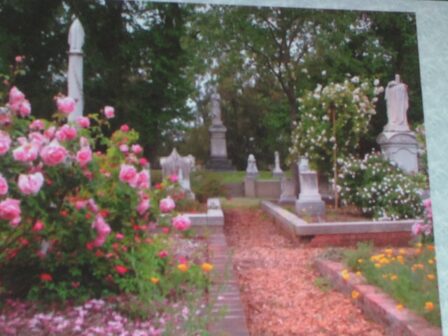Roses Remembered

Volunteers maintain the existing plants and collect lost or forgotten specimens which join the others in the historic garden.
Although it may be environmentally questionable to have rose gardens, Anita Clevenger, head of the National Rose Foundation, has a profound respect and love for roses, especially those no longer regularly seen. When she spoke at the February meeting of the San Diego Floral Association, Clevenger gave us a visual history of Sacramento’s Historic City Cemetery and the Historic Rose Garden within it. The Garden is dedicated to preserving the internationally recognized collection of found California roses and the Garden’s and roses’ history while educating the public about them. The Garden also enhances the city of Sacramento and its historic City Cemetery.
The history of Sacramento burials begins just outside Sutter’s Fort from 1839 until 1849 near the American River. Sutter Fort Burying Ground’s first interment was in 1845, but it was dedicated in 1849 when Captain John A. Sutter donated ten additional acres of land. This burial ground, renamed New Helvetia Cemetery, flooded in January of 1850. From then until 1857, floods precluded more burials. Eventually the city realized that you “don’t put a cemetery on low ground,” as Clevenger explained. With the river’s proximity and frequent flooding, a graveyard built in the lowlands was a potential health hazard. Nevertheless, it was not closed to burials until 1912.
The Sacramento City Cemetery’s history begins in 1849 with Captain John Sutter’s donation of another ten acres of land on high ground. By 1860 Sacramento had a cemetery designed as a Victorian garden.
The Victorians loved their roses. Not only did they paint pictures of them and use them for decoration and ornamentation, but frequently they planted bushes in their gardens and at their loved ones’ gravesites. These roses were carefully tended until no one alive knew anything about those in the graves. Eventually Sacramento’s city graveyard, its stones, and its roses suffered from neglect. Between the elements and vandalism, gravestones toppled, broke, or were defaced. Some of the roses, however, survived.
When Fred Boutin, a famous botanist and expert rosarian, saw the Sacramento City Cemetery, he could see past the dry, weedy and neglected grounds. Many of the gravestones had carvings of roses and rose buds as well as lambs and doves holding a branch with a rose bud. Boutin felt this was a perfect place for a repository of heritage roses that he and others had collected from all over California. In 1992, Sacramento set aside for the rose garden three of the ten acres donated in 1850 by the Sutter family for the cemetery.
California roses came from all over the world. The red and dark pink roses probably came from China. Others came from Europe. Settlers carried favorite bushes in their wagons and no doubt planted many on their journeys west. Along the Oregon Trails one finds wild yellow roses such as “Harr
ison’s Yellow.” These may have commemorated the graves of children and others who died during the difficult crossing. With no attention whatsoever, these roses still thrive.
Many of these roses are centuries old. Old Blush dates to our Revolution. A pink rose with yellow-red and peach tones, it blooms more than once a year and remains green year round. Autumn Damask, a European rose used for its fragrant oils, is a repeat bloomer and a cemetery favorite and may date from Roman times. Fortunately old roses are fairly tough and hardy.
Although the city of Sacramento supports the garden by providing irrigation systems and mulch, volunteers maintain the existing plants and collect lost or forgotten specimens which join the others in the historic garden. They collect, document, study, and identify the plants finding clues to their origin in botanical details. Many varieties of roses have disappeared as land is cleared to be developed for a miscellany of projects. Clevenger told us that often heritage rose lovers will see a plant believed to have been lost. She learned the hard way that it is essential to get a cutting from any rare old rose for propagation. Once, she and some colleagues saw three ancient rose bushes. They took cuttings from one. The following year Clevenger returned to see the others, but they were gone, perhaps forever. The one cutting she had prospered, however, and now is represented in Sacramento’s Historic Rose Garden.
We could see that the Sacramento City Historic Cemetery and Rose Garden are meeting their goals and enhancing California, not just Sacramento.
On April 23 come hear Gabe Selek describe the 2015 Panama-California Expo Centennial in Balboa Park from 6 to 8 p.m. at the church at 4070 Jackdaw.
Category: Local News







